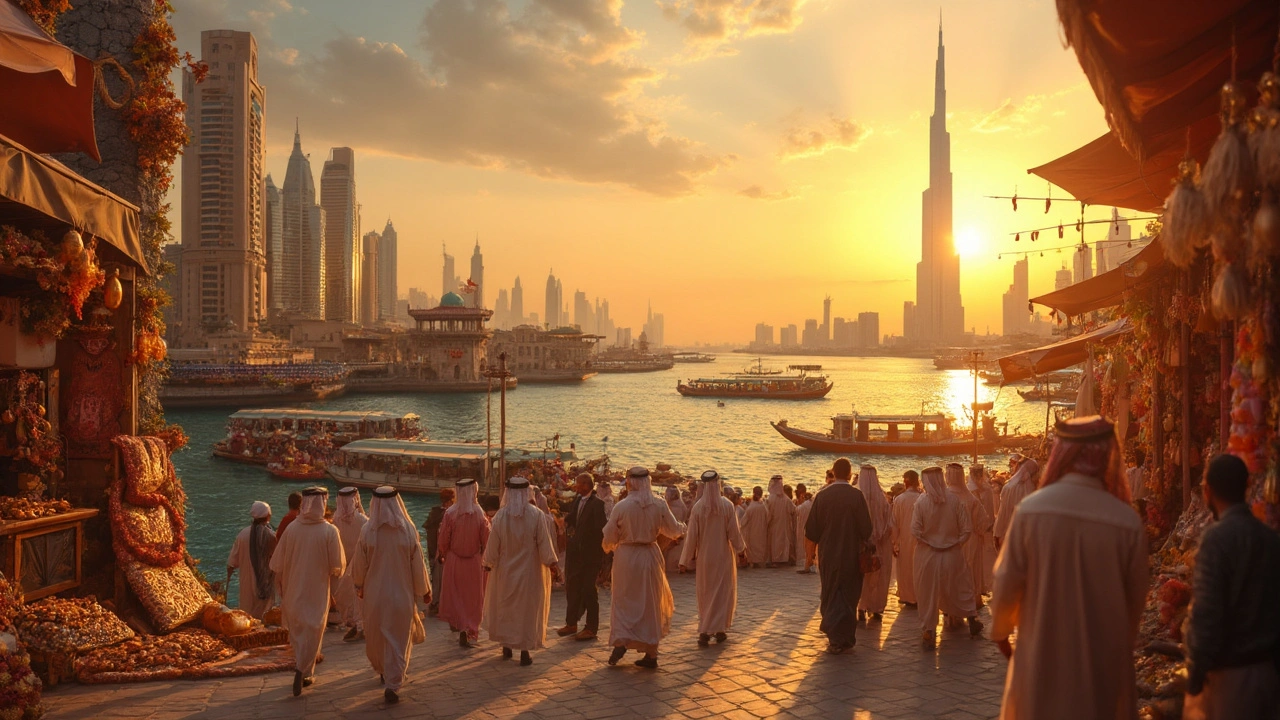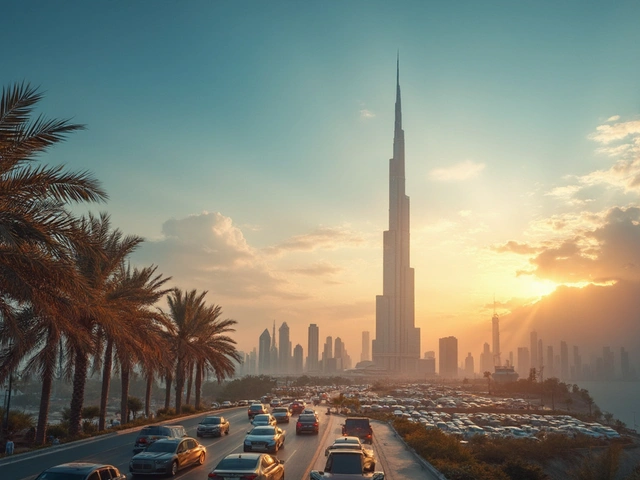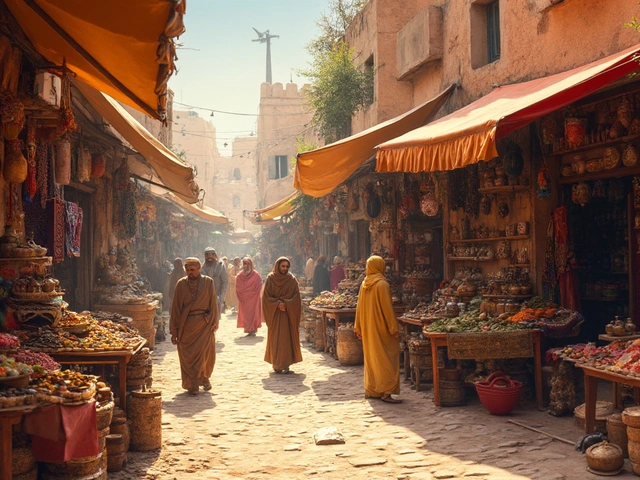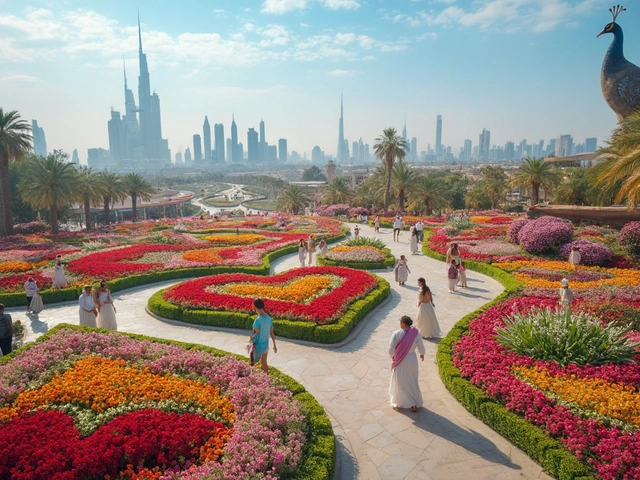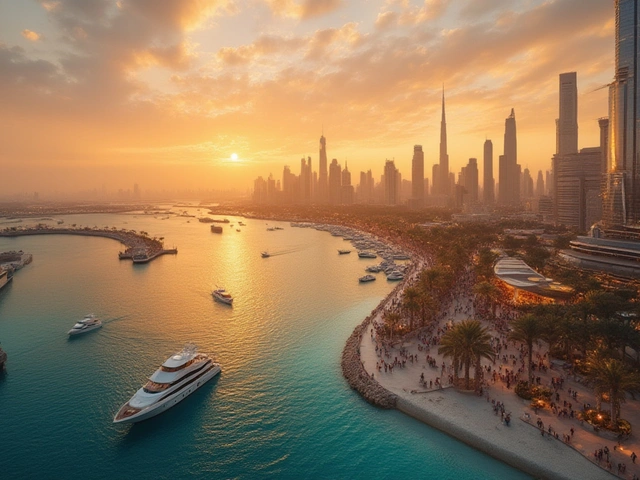Dubai attractions can honestly feel overwhelming—there’s that much on offer. The thing to know? You won’t run out of places to see or things to do, even if you stick around for months. The city’s not just about the Burj Khalifa or luxury malls; there’s a wild energy in the winding alleys of old Deira and a calm you’ll only find sipping karak on a side street in Satwa.
First-tip: get familiar with the Metro—it’s clean, cheap, and connects you to the city’s top landmarks in minutes. Friday is the UAE weekend, so spots like Downtown Dubai, Dubai Mall, and the Creek get packed early. If you want iconic views, head up the Burj Khalifa just before sunset, but book tickets in advance. For an old-school Emirati vibe, ditch the taxi and take an abra across Dubai Creek; it’ll cost you just one dirham and gives you a real glimpse into daily life here.
Shopping’s another story. The city lives for its gold souks, but places like Alserkal Avenue offer art, indie cafes, and truly one-off finds. And don’t worry if you can’t speak Arabic—most people here switch between English and Arabic all day long. Just remember to dress modestly in traditional areas and public spaces; it goes a long way in showing respect, especially during Ramadan.
- Landmarks That Define Dubai’s Skyline
- Hidden Bazaars and Modern Markets
- Desert Adventures and Natural Escapes
- Celebrating Emirati Culture
- Family Fun and Unexpected Experiences
- Getting Around: Practical Tips for Dubai
Landmarks That Define Dubai’s Skyline
Dive into the heart of Dubai, and you can’t miss those crazy tall and unique buildings popping out of the desert. First up, the Burj Khalifa—it’s still the world’s tallest building at 828 meters. Take the elevator to the 124th floor for killer views, but honestly, the 148th-floor Sky Lounge is way less crowded (and you get snacks). Book your slot online, especially in winter or holiday season, or you’ll be waiting for ages.
Next, swing by the Burj Al Arab. It’s the sail-shaped hotel sitting on its own little island, and even if you’re not staying there, plenty of folks grab a drink at the Skyview Bar for the Instagram shot. They’re pretty strict about dress codes, so leave the shorts at home. Nearby, Jumeirah Beach has awesome views of the Burj Al Arab and is free to access.
Another one to tick off: Dubai Frame. This 150-meter picture frame is legit—inside, you get a glass-floored sky bridge, and a split-view: old Dubai on one side, new Dubai on the other. Cheap ticket, quick lines, and it’s fun for everyone.
- Burj Khalifa: Tallest in the world, two observation decks, try for sunset.
- Burj Al Arab: Iconic hotel, need a reservation to go inside, best seen from Jumeirah Beach.
- Dubai Frame: Panoramic views, a quick and easy stop with cool photo ops.
- Cayan Tower (the “Twisting Tower”): In Dubai Marina—look up and see how the floor plate rotates 90 degrees. No need for a ticket—just snap a shot from the promenade.
- Atlantis, The Palm: Madness on the Palm Jumeirah Island; families love it for the Aquaventure waterpark, but even walking in the lobby feels like you’re on another planet.
| Landmark | Height | Entry Fee (AED) | Hours |
|---|---|---|---|
| Burj Khalifa | 828m | ~149-370 | 8am–11pm |
| Dubai Frame | 150m | 50 | 9am–9pm |
| Burj Al Arab (Skyview Bar) | 321m | 180 (min. spend) | 12:30pm–11pm |
| Atlantis, The Palm (Aquaventure) | ~93m (hotel) | 299 | 10am–6pm |
One thing most people miss: catch the Dubai Fountain show right outside Dubai Mall every evening (every 30 minutes from 6pm). It’s loud, bright, and totally free. For something chill, walk the new Dubai Water Canal boardwalk after dark—the skyline lights up, and you’ll see locals out jogging or grabbing karak.
Hidden Bazaars and Modern Markets
Dubai might look flashy with its mega-malls, but at its core, it’s still a city that loves its old-school markets. If you’re after the true Dubai attractions experience, start at the Gold Souk in Deira. Here, you’ll see rows of shops stacked with gold chains, 22- and 24-karat bangles, and necklaces you didn’t know existed. It's not just for tourists either; locals haggle here with the same energy. The prices change daily based on global rates, and the window displays are mind-blowing. If you're hunting for perfumes, the Perfume Souk just a few blocks away will hit you with scents you’ve never smelled before—think oud, amber, and custom blends you can’t get outside the Gulf.
Now, cross over to Bur Dubai and you’ll land in the Textile Souk. This spot is lined with tiny shops selling pashminas, silks, and local kanduras. Bargaining is totally expected, so don’t feel weird asking for a discount, especially if you’re buying more than one item. The best time? Go late afternoon, once the heat eases up. There’s no rush and most shop owners are happy to chat over tea.
Switch gears and you’re in a different world at Dubai Mall and Mall of the Emirates. Both have the usual big-name brands, but also things you won’t see anywhere else—like the indoor ski slope at Mall of the Emirates and the Dubai Aquarium at Dubai Mall. These aren’t just shopping spots—they’re real hangouts, especially when it’s 45°C outside. City Walk and Alserkal Avenue keep things fresh with local fashion, homegrown coffee shops, and rotating art events.
If street-food is on your list, try the Waterfront Market in Deira. It’s where Dubai’s chefs shop daily for fresh fish, straight off boats from the Gulf. You can pick your own seafood and get it cooked on the spot in one of the nearby restaurants—that’s dinner and a story for your Instagram.
- Always ask for the ‘best price’ at a souk—it’s expected.
- Cash is king in older markets, but malls and bigger stores take cards.
- Friday mornings are quietest in the Gold Souk; late evenings get lively fast.
- In malls, keep an eye out for shopping festivals and mega-sales—Dubai does them big. Dubai Shopping Festival (usually in January) draws deals you won’t see elsewhere.
| Market/Mall | Main Highlights | Best Time to Visit |
|---|---|---|
| Gold Souk | Gold, Jewelry, Haggling | Morning, Early Afternoon |
| Textile Souk | Fabrics, Tailoring, Scarves | Late Afternoon |
| Dubai Mall | Shopping, Aquarium, Dining | Weekdays, Early Evening |
| Mall of the Emirates | Ski Slope, Retail Brands | Mornings, Weekdays |
| Waterfront Market | Seafood, Spices, Local Eats | Morning for freshest catch |
Whether you’re chasing luxury in the malls or the hustle in the souks, Dubai attractions offer a shopping and culture shock that’s hard to beat. Sharpen those bargaining skills, bring a reusable bag, and always double-check the opening hours—Ramadan or public holidays can shift schedules without much notice.
Desert Adventures and Natural Escapes
Dubai is built on the edge of the desert, and you’re missing out if you skip the open dunes just beyond the skyscrapers. Not just for the Instagram crowd, desert safaris give you a solid taste of the real UAE—camels, sandboarding, endless red dunes, and nights under the stars. Tour operators like Platinum Heritage and Arabian Adventures are trusted names, and they’re the ones running trips with licensed guides and proper safety standards. Basic tours usually include dune bashing (hold on tight—it’s a wild ride), short camel treks, and a barbecue dinner at a Bedouin-style camp. For a fancier experience, there’s falcon displays and even astronomy sessions after sunset.
If you’re into numbers, check out these prices and timings:
| Activity | Typical Cost (AED) | Best Time to Go |
|---|---|---|
| Dune Bashing & BBQ Dinner | 150–300 | November–March (cooler season) |
| Overnight Desert Camp | 400–800 | December–February |
| Hot Air Balloon Ride | 950–1300 | September–April (early morning) |
Pack light for these trips. Eyewear, sunscreen, and a light jacket make life easier, especially if you stay into the chilly desert night. Sand gets everywhere—flip-flops are better than shoes. If you’re hoping to catch a sunset or try photography, prime time is late afternoon. Ramadan or hot summer months mean shorter tours and fewer crowds, but also, the heat gets intense fast.
Want something truly local? Head east toward Hatta, just 90 minutes away. Hatta Dam offers kayaking with mountain views, biking trails, and cooler air in winter. The Hatta Wadi Hub is gaining popularity for ziplining and wall climbing. All this brings a welcome break from city life, especially for Dubai residents needing a nature fix.
Back in the city, Ras Al Khor Wildlife Sanctuary sits just off Dubai Creek. Even locals miss this spot, but it’s one of the best places to see flamingos in the wild from November to April—yep, real ones, not the plastic kind. Entry is free and the hides have binoculars for bird-watching, which makes it easy to fit a natural escape into a busy Dubai day.
- Book desert experiences with licensed operators—unlicensed tours can be sketchy and often cut corners on safety.
- Check the weather before booking, especially if you hate the heat—midday desert sun can hit 40°C plus in peak summer.
- Keep water, a power bank, and spare camera memory on you; you’ll need it once those red dunes start glowing at sunset.
All in, Dubai attractions don’t stop at malls and towers. A few hours in the desert adds a whole new spin to your trip.
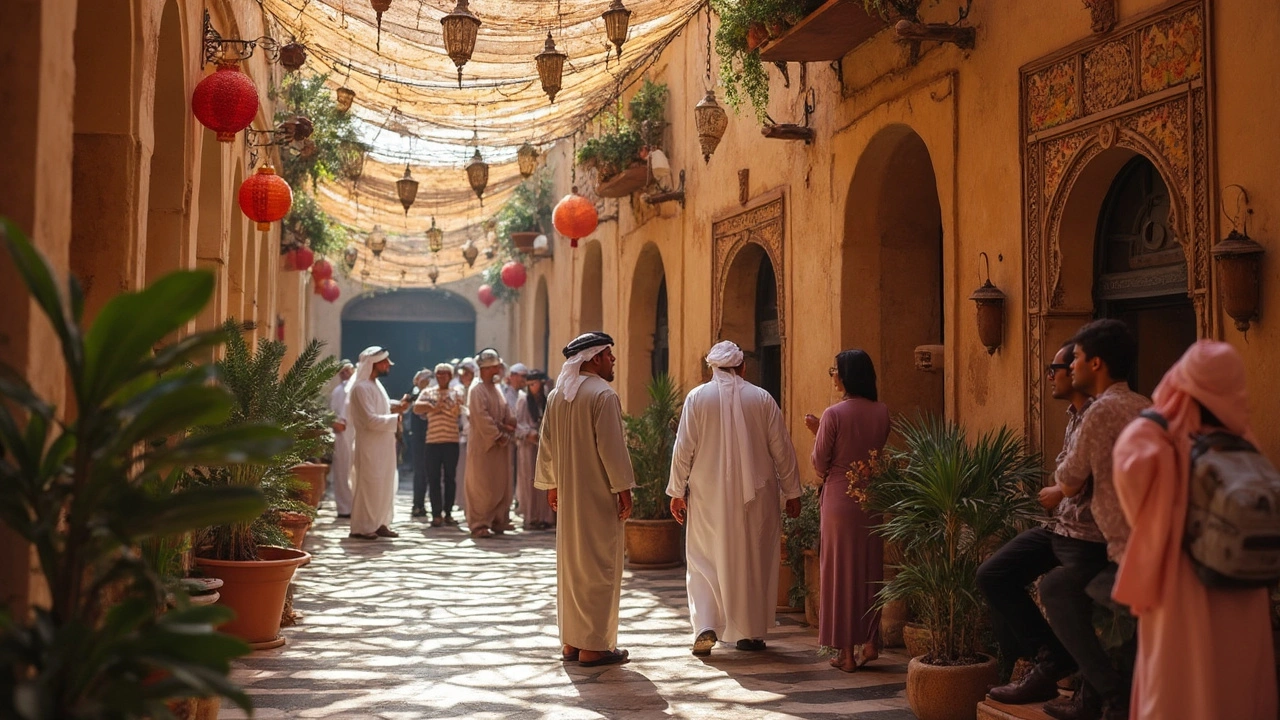
Celebrating Emirati Culture
To really get Dubai, you’ve got to tap into what makes Emirati culture tick. Because behind the high-rises and the malls, there’s a daily rhythm that goes back centuries. Don’t skip the Dubai attractions like the Al Fahidi Historical Neighborhood (also called Al Bastakiya). Its narrow lanes, art galleries, and wind towers show how people beat the heat and lived before air conditioning became a thing. Visit the Dubai Museum in the old Al Fahidi Fort—built in 1787, it’s one of the city’s oldest buildings and packs in stories about pearl diving, trade, and life along the coast.
If you’re hungry, sign up for an Emirati food tour. These usually serve up dishes like machboos (fragrant rice with meat) and chebab (Emirati pancakes), and you’ll often get to chat with local hosts over karak tea and dates. Ramadan is a huge part of life here—non-Muslims aren’t expected to fast, but it’s respectful to avoid eating in public during daylight hours. Iftar buffets in restaurants are massive, and anyone can join in for a real taste of local hospitality.
"Our heritage and culture are the core of our identity in Dubai. We embrace visitors and invite them to learn about our traditions, values, and hospitality." — Dubai Culture & Arts Authority
- Jumeirah Mosque is the top spot for public mosque tours. Try their ‘Open Doors, Open Minds’ program—they answer every question you’ve got about Islam and local customs.
- Watch for camel races at Al Marmoom Racetrack (winter months are best).
- Hit up events like the annual Emirates Airline Festival of Literature and Sikka Art Fair. Both show off the creative side of Dubai’s Emirati and expat community.
The dance scene’s got deep roots too—Al Ayala (the traditional stick dance) is performed at celebrations and sometimes in the malls during national holidays. If you see locals wearing kanduras (white robes) and abayas (black cloaks), it’s a sign of respect and pride in tradition, not just a dress code.
| Cultural Spot | Location | Entry/Availability |
|---|---|---|
| Al Fahidi Historical Neighborhood | Bur Dubai | Free/Year-round |
| Dubai Museum | Al Fahidi Fort | Low fee/Year-round |
| Jumeirah Mosque Tour | Jumeirah 1 | Small fee/Saturday-Thursday, morning |
| Al Marmoom Camel Racetrack | Desert outskirts | Free/Winter season |
Honestly, whether you’re into food, crafts, art, or sports, Dubai’s mix of modern life and old-school Emirati traditions is everywhere—you just have to know where to look. And don’t hesitate to ask questions. Locals and long-time residents love sharing their slice of Dubai with visitors.
Family Fun and Unexpected Experiences
Think you know family activities in Dubai? There’s more than just mega-malls and water parks. Sure, you’ll find classic crowd-pleasers like Dubai Aquarium & Underwater Zoo at Dubai Mall, where kids can see actual sharks gliding overhead. But there’s more—OliOli, an interactive kids’ museum in Al Quoz, has eight different galleries that get children building, tinkering, and just generally burning energy in a way you’ll wish was around when you grew up.
IMG Worlds of Adventure is still the world’s largest indoor theme park, so don’t count it out when the desert heat peaks. They’ve got everything from Marvel superheroes to giant dinosaurs, and unlike most places, you won’t melt in the midday sun since it’s air-conditioned to the max. Another top pick: Global Village, open in the winter months, turns shopping, street food, and performances from around the world into a massive fairground — think of it as a global street party, UAE-style.
For something off the usual tourist path, check out The Sustainable City out off Al Qudra Road. It’s a totally eco-friendly neighborhood where families can bike around, see community farms, and get a taste of sustainable living — it’s even won awards for being one of the greenest places in the Middle East.
- Dubai Miracle Garden blooms between November and April, stacking over 150 million flowers into wild shapes and colors. Yes, it’s real flowers, in the desert.
- If your kids are animal lovers, Dubai Safari Park (open October–May) spreads across 119 hectares, home to giraffes, lions, and even Asian elephants.
- For a quick break from the glitz, Al Marmoom Desert Conservation Reserve lets families spot native wildlife or take a sunrise hot-air balloon ride above the dunes.
Catching the unexpected? Try ice skating at Dubai Ice Rink, right inside The Dubai Mall, or test your nerves at Jumble, the city’s wildest indoor urban maze. And don’t rule out Al Seef by the Creek for relaxed evening strolls, food trucks, and dhow boat rides — perfect for a low-key family night.
Here’s a look at some Dubai family attraction stats, so you know what’s busy and when:
| Attraction | Annual Visitors | Best Time to Visit |
|---|---|---|
| Dubai Mall Aquarium & Underwater Zoo | 2.5 million | Morning, weekdays |
| IMG Worlds of Adventure | 1.3 million | Afternoons, off-peak |
| Global Village | 7 million (seasonal) | Weeknights, November–April |
| Dubai Safari Park | 1 million | Weekdays, October–March |
When you’re mapping out Dubai attractions for families, make sure to double-check seasonal openings. Some spots pack up for summer and swing back in cooler months, which is just how things roll with the UAE’s wild temperatures.
Getting Around: Practical Tips for Dubai
Getting around Dubai is surprisingly easy if you know the basics. The city’s public transport is modern, safe, and runs on time. The Dubai Metro is your friend—two lines (Red and Green) cover most of the main sights. The Red Line hits those classic Dubai attractions like Burj Khalifa, Mall of the Emirates, and Dubai Marina. Trains start early in the morning and most stations have direct links to shopping centers or business towers.
If you’re headed somewhere not on the Metro—like Jumeirah Beach or neighborhoods with hidden cafes—don’t stress. Taxis are everywhere, and apps like Careem or Uber make booking one simple. Taxis are metered and drivers usually speak English. If you want a cheaper ride, use the city’s public buses. For a scenic route, there’s the Dubai Tram, especially handy in the Marina and JBR areas.
Payment is easy: get a Nol card. You can load money on it and use it for Metro, bus, tram, and even some ferries. Nol cards sell at all Metro stations and major bus terminals. If you’re just visiting, the Red Nol card works best for pay-as-you-go. Locals and expats who stay longer often get the Silver or Gold cards.
Here’s an honest tip: traffic jams happen, especially on Sheikh Zayed Road during rush hour—around 7-9 am and 5-8 pm. If you can, take public transport or travel outside these peak times. Parking downtown can be tricky and expensive, so leave the rental car behind unless you’re exploring the desert or suburbs.
Want to see old Dubai? Hop on an abra (that’s a traditional wooden boat) across the Creek. It’s only AED 1 per ride and operates from sunrise to midnight. The RTA Water Bus and Water Taxi are cool options too, especially with kids or if you want city views from the water.
Transport Options & Costs (2025):
| Option | Average Cost | Tip |
|---|---|---|
| Dubai Metro | AED 3 – AED 7.5 per trip | Runs every few minutes |
| Abra Ride | AED 1 | Pay cash |
| Taxi (Start Rate) | AED 12 (day) / AED 13.50 (night) | Careem/Uber for app rides |
| Nol Card (Red/Silver) | AED 2 (Red), AED 25 (Silver incl. AED 19 credit) | Available at Metro stations |
| RTA Buses | AED 3 – AED 8.5 | Use Nol card |
| Car Rental | Starts from AED 60/day | Bring an international license |
Dress for the weather—May to September is hot, so lightweight clothes work, but still keep it modest in public spaces. Drinking water on the Metro or eating on public transport is a no-go and can land you a fine. Lastly, if you get stuck or lost, RTA staff are usually happy to help and most signage is in English and Arabic.

